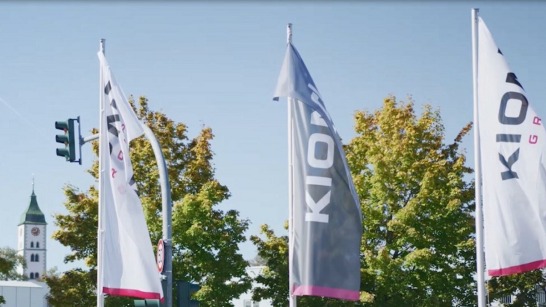As he introduces visitors to the innovative, groundbreaking machine which possesses the ability to ‘see’ and selectively ‘choose’ items, Kevin Heath, Manager, Sales Engineering, insists he has not given the brightly colored piece of equipment a name. “I just call it ‘the green robot’,” he says rather matter-of-factly as he discusses the collaborative robot behind him performing tasks that humans typically do in warehouse order fulfilment.
Perhaps, it is important to state right now that KION Group’s robotics center of excellence – as well as its various innovation centers scattered around the globe – are not filled with cyborgs and cuddly little R2D2s racing about the premises blinking and beeping, but rather sophisticated and complex machines performing piece picking tasks within order fulfilment processes. Still, when watching this brand-new technology in operation, one cannot help but think it is human.
Indeed, when Heath describes the developments being made with these machines, he peppers his responses with phrases such as “how a robot learns…” and the “robot is instructed” or “you can get very close and personal to them”. Observing Dematic’s latest innovative robotic piece picking solution in action – the process of picking up an item and placing it in a container – it is hard to describe the amazing technology without using attributes typically associated with human achievement.
As Crystal Parrott, Vice President, Robotics Center of Excellence, sees it, the innovation for the piece picking solution developed can be found in three performance areas: the imaging and perception technologies, the computational analysis and data crunching that comes with it as well as in the end effector or end-of-arm tooling.
The Dematic robotic piece picking solution handles objects like a human while offering the accuracy, reliability and efficiency of 24/7 automation. It is a modular, vendor-agnostic articulated arm that offers advanced item recognition and adaptable grasp-planning dexterity.
“Digital transformation is actually just an extension of automation because automation has the actual sensing technologies built in for robotics already but now all of a sudden we can use it in a lot of different ways and incorporate it into new software sets and algorithms that allow robotics and automation applications to be expanded – mobile ‘bots’, ‘cobots’, high vision, perception, intelligence, AI – all of that is possible because of the use of the data that is being generated by all of the pieces that are now part of a robotics system,” explains Parrott.
The robotic piece-picking solution is not only taking Dematic’s current palletizing and depalletizing technologies to the next level by extending the benefits of repeatable-task automation further into order fulfillment operations, but it is also paving the way for future innovations in the journey to a lights-out facility, such as mobilized robot-to-goods automation and AI-enabled cognitive automation.
“With digitalization, we can now take the existing information that we have and transport it into a virtual world so that we are able to utilize the data offline and in process at the same time. Previously, you could simulate but you could not do it in real time, nor was it fast enough; it could not be part of the actual process. But now the ability to do this instantaneously - being able to handle ‘big data’ and make actual decisions quicker and sooner – that’s what is transformative,” says Parrott.
With more than 28 years of experience in automation and robotics, Parrott’s enthusiasm as she describes the changes taking place in the industry is clearly contagious and nowhere is it more noticeable than when she discusses AI as a game changer in allowing robotics to be implemented in the logistics space.
“One of the biggest software application advances impacting the robotics here at Dematic is the artificial intelligence aspect now available through machine learning and deep learning techniques.
And as the software and these toolsets become more available, they will allow a robot to be more dynamic in its environment because it can learn how to do things better.”
How does that work with a robot? Heath explains that through successful and unsuccessful picking, the digital software stores both types of picks and the data around them, and then offline, a resource will analyze the information. Through multiple iterations, the robot will remember the successful and unsuccessful ones and the algorithms will be modified so the next time it sees the image, it will know where to select the specific item.
According to Parrott, one of the industry misperceptions regarding the mass adoption of robotics in warehouse systems is the fact that because the technologies are still evolving and there is not yet a comprehensive set of solutions to address all areas of a warehouse, then there is a fear that the use of robotics will not be viable. She strongly believes that the premise is simply flawed and companies mulling over the integration of a robotics system should instead be thinking of taking incremental steps as they introduce the new technology into their spaces. She instructs they should give the technology time to advance and then incorporate and upgrade accordingly. In other words, it is not a black-and-white decision whether to transition but needs to be a measured, long-term investment closely aligned to overall strategic goals.
Heath points out that the rapid expansion of ecommerce and the shift to single-item picking has placed enormous pressure on traditional labor-intensive picking operations. When you combine this with deep labor shortages in many regions of the world – particularly Europe and North America – and you throw the rise in hourly wages into the mix, he and his colleagues are now seeing a growing interest in using robotic technology to fill the gaps. And he does not believe the current situation will let up.
At the end of the day, Parrott says the overall objective at Dematic and KION is to provide customers with an optimized warehouse operation and that does not mean specifically employing a single technology, but to employ different pieces of technology and solution sets that when they work together, they improve the operations of a facility.

